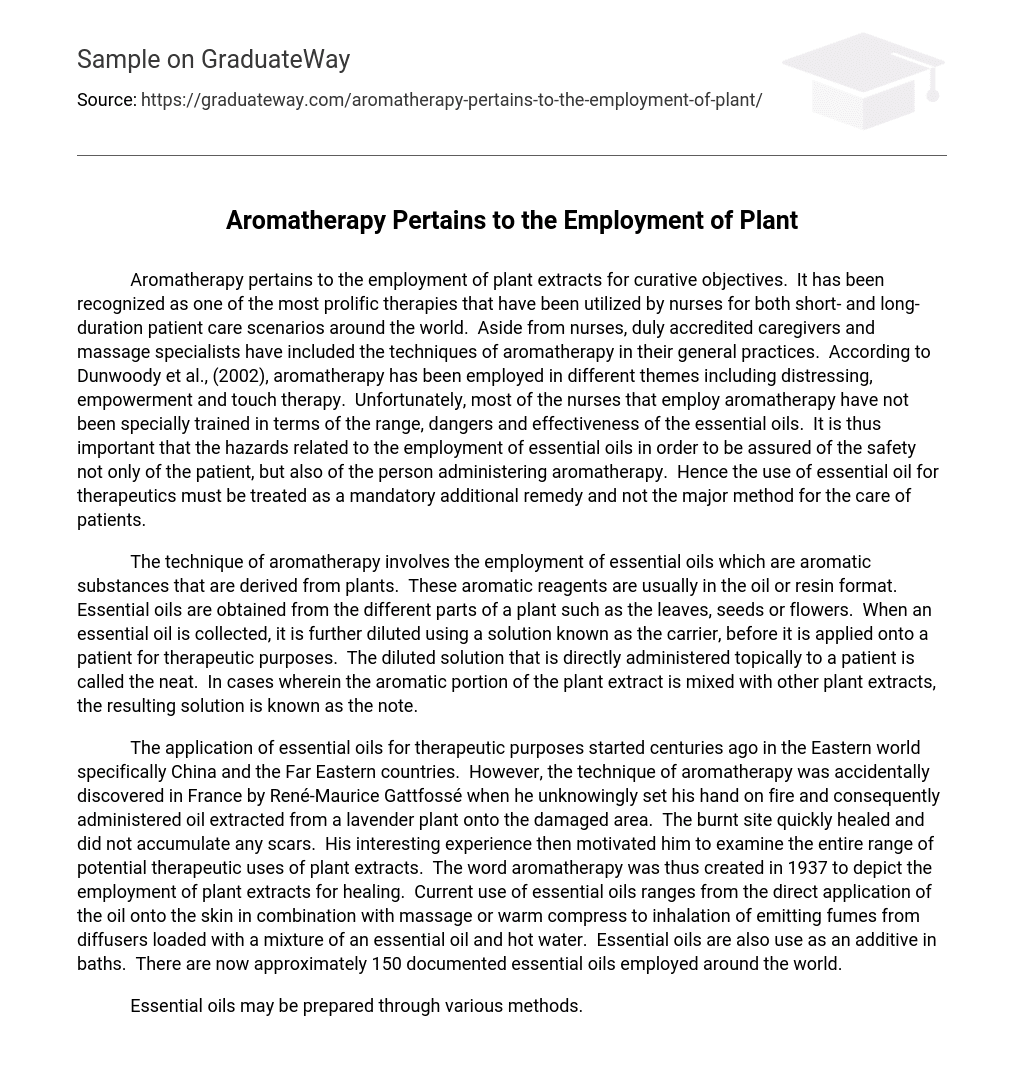Aromatherapy pertains to the employment of plant extracts for curative objectives. It has been recognized as one of the most prolific therapies that have been utilized by nurses for both short- and long-duration patient care scenarios around the world. Aside from nurses, duly accredited caregivers and massage specialists have included the techniques of aromatherapy in their general practices. According to Dunwoody et al., (2002), aromatherapy has been employed in different themes including distressing, empowerment and touch therapy. Unfortunately, most of the nurses that employ aromatherapy have not been specially trained in terms of the range, dangers and effectiveness of the essential oils. It is thus important that the hazards related to the employment of essential oils in order to be assured of the safety not only of the patient, but also of the person administering aromatherapy. Hence the use of essential oil for therapeutics must be treated as a mandatory additional remedy and not the major method for the care of patients.
The technique of aromatherapy involves the employment of essential oils which are aromatic substances that are derived from plants. These aromatic reagents are usually in the oil or resin format. Essential oils are obtained from the different parts of a plant such as the leaves, seeds or flowers. When an essential oil is collected, it is further diluted using a solution known as the carrier, before it is applied onto a patient for therapeutic purposes. The diluted solution that is directly administered topically to a patient is called the neat. In cases wherein the aromatic portion of the plant extract is mixed with other plant extracts, the resulting solution is known as the note.
The application of essential oils for therapeutic purposes started centuries ago in the Eastern world specifically China and the Far Eastern countries. However, the technique of aromatherapy was accidentally discovered in France by René-Maurice Gattfossé when he unknowingly set his hand on fire and consequently administered oil extracted from a lavender plant onto the damaged area. The burnt site quickly healed and did not accumulate any scars. His interesting experience then motivated him to examine the entire range of potential therapeutic uses of plant extracts. The word aromatherapy was thus created in 1937 to depict the employment of plant extracts for healing. Current use of essential oils ranges from the direct application of the oil onto the skin in combination with massage or warm compress to inhalation of emitting fumes from diffusers loaded with a mixture of an essential oil and hot water. Essential oils are also use as an additive in baths. There are now approximately 150 documented essential oils employed around the world.
Essential oils may be prepared through various methods. The most frequent technique employed in extracting essential oils is through steam distillation. However, it is also possible to collect essential oils through the simple solvent extraction technique. Extraction commonly generates a condensed fluid that still contains the active ingredients of the natural oil. Essential oils affect the olfactory sensation of an individual, which in turn sends a signal to the limbic system which is responsible for the emotional condition of an individual. The limbic system also plays a major role in creating memories in the brain of a person. An essential oil has the capacity to pass through the skin and the underlying fatty tissues, eventually entering the circulatory system through the bloodstream. Caution should be taken when employing essential oils because there are some commercial aromatherapy products that have been determined to be synthetic or impure. Pure essential oils are easier to purchase during crop season. In addition, care should also be taken in commercial aromatherapeutic products because farmers often administer pesticides to the plant and these reagents may be included during the extraction process for essential oils. Essential oils should not be confused with culinary aromatic plants or herbs. Most of the essential oils are derived from herbs but the oils are generally prepared in a concentrated format hence an essential oil from rosemary may not be used for cooking because these oils contain high doses of the active ingredient and these may be toxic if ingested.
It has been reported that aromatherapy has improved the conditions of cancer patients in terms of pain management, control of blood pressure and levels of depression (Louis and Kowalski, 2002). However, Research shows that the use of aromatherapy in the clinical setting has not effectively helped in the palliative care of patients diagnosed with cancer (Westcombe et al., 2003). Amidst the widespread use of essential oils for different clinical settings, there have also been reports of side effects observed from the application of essential oils on specific individuals. It has been determined that essential oils may affect the normal progression of pregnancy as well as interfere with the recovery of an individual with a contagious disease. There are also random reports that have linked the use of essential oils with disorders of the circulatory system such as venous thrombosis and varicose veins. It has also been reported that essential oils may affect disorders of the nervous system such as epilepsy. Isolated reports have also been issued with regards to the reduction of effects of pharmaceutical drugs when administered in combination with essential oils. Hence there is an urgent need to perform comprehensive analysis of the positive and negative effects of aromatherapy and its associated essential oils in order to set the standards with regards to its administration to patients.
References
Dunwoody L, Smyth A and Davidson R (2002): Cancer patients’ experiences and evaluations of aromatherapy massage in palliative care. Int. J. Palliat. Nurs. 8:497–504.
Louis M and Kowalski SD (2002): Use of aromatherapy with hospice patients to decrease pain, anxiety, and depression and to promote an increased sense of well-being. Am. J. Hospice Palliat. Care 19:381–386
Westcombe AM, Gambles MA, Wilkinson SM, Barnes K and Fellowes D (2003): Learning the hard way! Setting up an RCT of aromatherapy massage for patients with advanced cancer. Palliat. Med. 17:300–307..





